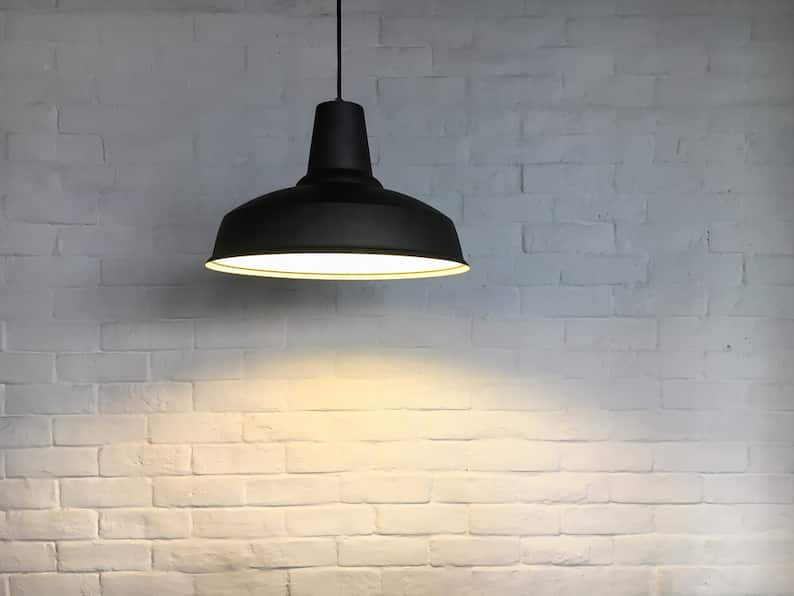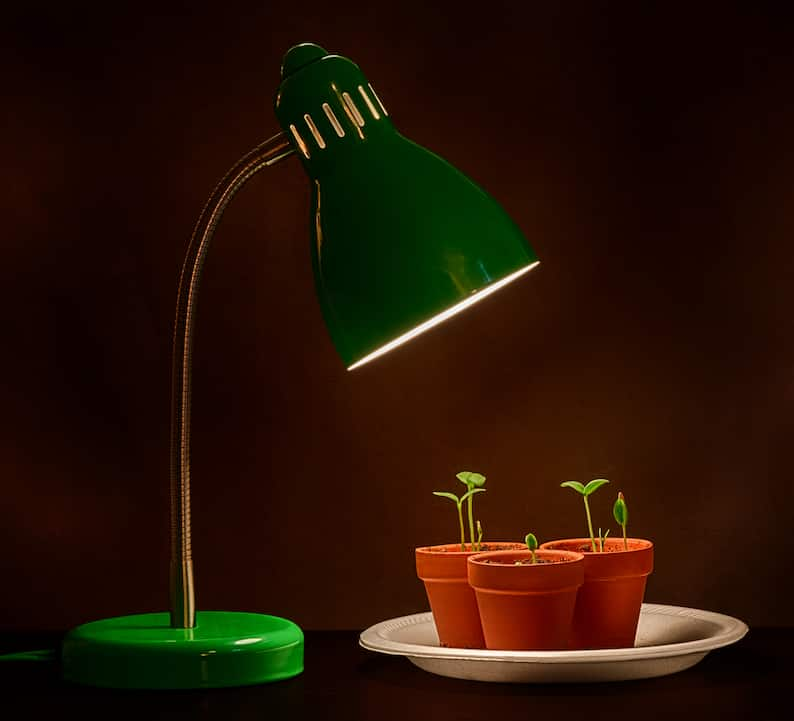When you realize that your plants aren’t getting all the natural light they need, considering the various grow light options that are out there is a good first step. From there, it probably won’t take long until you find out about the existence of LED grow lights, as there’s a reason they’re the most popular type of grow light. But surely they’re the same as the LED lights you already have at home, just more expensive?
After all, what is the difference between LED lights and LED grow lights? Can’t any LED light be used as a grow light?
Well, not quite. When your goal is to ensure your houseplants grow thicker or start to bloom, it’s important to be aware of not only the different types of grow lights out there, but how they differ to their more standard variations. And as you’ll see, while it’s true that an LED grow light may cost slightly more than a regular light bulb, the benefits more than make it worthwhile.

Table of Contents
What’s the difference between LED lights and LED grow lights?
The difference between household LED lights and LED grow lights is that the purpose of household LED lights is to illuminate the space around them. LED grow lights, however, have red and blue wavelengths that are optimized for promoting plant growth.
As mentioned above, growing with off the shelf LED bulbs is possible as they do contain some of the wavelengths that plants need to thrive. However, if you’re serious about growing plants indoors with artificial light, it’s better to invest in actual LED grow lights to encourage plant growth.
I’ll cover below how effective normal LED lights are for growing plants. However, spoiler alert: I always recommend getting a plant-specific, full-spectrum LED grow light, like these, to really make sure your plants are getting what they need.
Can LED lights grow plants?
Plants will likely survive under regular LED lights, although it’s more effective to use LED grow lights if you’re looking to promote growth in your plants. This is because the wavelengths produced by normal LED lights aren’t concentrated enough to fully meet all of a plant’s needs.
When I refer to “wavelengths” here, I’m basically talking about the color of light, as scientists use wavelength numbers to measure colors. This is because it’s much more accurate to talk about a light with wavelengths between 450 and 500 compared to simply saying “blue”.
What you’re looking for in LED lights for growing indoor plants is light that contains the right balance of colors (that is, the right wavelengths), as this is what plants need to thrive. If you think about it, plants naturally need sunlight to survive and sunlight naturally contains every color of the spectrum (with more blue and red than the others – this becomes important a bit further down). This is why even though sunlight may look white, your window can sometimes cause a rainbow as it refracts a ray of sun.
Here’s our top pick for the best LED grow light out there:

Regular LED lights, however, usually only contain yellow and white. While these can have some benefits, which is why plants can grow (or at least survive) minimally under normal LED lights, if needed, they won’t provide the full benefits that LED grow lights for plants produce.
You can see an explanation below on the benefits of each of the colors
- Blue light (400–500 nm) helps your plant’s foliage become thicker. The other side of this coin is that too much blue light can make your plant compact and overly thick (which may actually be what you’re looking for, depending on the plant).
- Green light (500–600 nm) prompts some scientific debate regarding its usefulness but, as a general rule, it isn’t actually needed by plants. In fact, it’s why plants are green – as they reflect all green light back instead of absorbing it to help with growth.
- Red light (600–700 nm) encourages blooming and fruiting in your plant, as well as promoting stem and leaf growth. This means that red light is particularly important just before your plant is expected to flower.
Keep in mind: Full spectrum white LED grow lights are considered the best for plant growth these days. The fact that these are white shouldn’t be confused with the white light emitted by standard LED bulbs. Instead, they consist of a combination of all the colors your plants need to grow, which is why they appear white, much like natural sunlight.
What are the different types of grow lights for indoor plants?
The different types of grow lights for indoor plants consist of the following:
- LED lights: These give off next to no heat and need very little power to operate, making them very cost effective to run. As described above, they can be tailored towards the different needs of different plants by adjusting the color temperature to provide for more of one light wavelength (i.e. their color) over another.
- Incandescent bulbs: These are your usual, everyday bulbs you’ll find around most houses. While they’re very cheap to buy, they’re much more expensive to run based on output. They also give off more heat than other types of grow lights, so you can’t put them too close to your plants.
- Fluorescent lights: A popular choice for the everyday gardener as they can be cheaper than LED lights and aren’t as hot as incandescent bulbs. While plants can grow under these, they often don’t have the full range needed to really encourage flowering, but may be fine if you’re looking to grow vegetation.
- High intensity discharge lights: These are more for pros given the cost needed to buy and operate them. They are, however, very energy efficient and are particularly good for those who need blue light for vegetative growth
Are LED lights good for plants?
LED grow lights are good for plants as they mimic the effect of natural sunlight. This means that they’re designed with colors that give your indoor plants the wavelengths they need to grow and thrive. They also use low amounts of energy and emit low amounts of heat, especially compared to fluorescent or incandescent lights.
All this means that If you plan to grow plants indoors (and aren’t dealing with a plant that prefers no sunlight), buying an LED light for plants is the best way to ensure that they’re able to grow. This is especially the case if you have plants that need some light to survive but they’re not able to get this naturally, whether it’s due to lack of available space outside or near a window that’s facing in the right direction or even simply due to the area you live in.
In brief, it’s safe to say that LED lights help plants grow.
Did you know: The effect of LED lights on plants (like my preferred LED grow light here) can, in some cases, result in them growing faster and healthier than if they were outside. This is because you’re able to closely set just how much and what type of light your indoor plants get, meaning the conditions can be perfectly tailored to your plants’ needs compared to outside where this option isn’t available (and, consequently, where you’re more likely to be faced with signs that your plant is getting too much light).
Can any LED light be used as a grow light?
You can’t use a normal LED light to grow plants indoors. Instead, only LED grow lights are color optimized to stimulate growth in your plants. While a standard LED light will have some of what your plants need, it won’t have enough red and blue light for your plants to thrive.
As mentioned above, the main purpose of regular LED lights is to, well, provide light. They do this by usually giving off white light along with some yellow, which you probably recognize if you’ve ever seen one in person. This makes them great for their intended purpose and better for the human eye.

However, that isn’t the purpose of LED grow lights. Instead, they’re optimized with different amounts of blue and red light (and sometimes some others) to encourage your plants to grow. You can always adjust these colors, which some people do depending on their plant goals.
For instance, if you want your plant to flower or grow fruit, a grow light with more red in it is generally better. But either way, it’s a combination of these colors that will stimulate growth in your plants, not the white-yellow light that a standard LED produces.
Can a regular light bulb help plants grow?
Some types of regular light bulbs can help plants survive, if needed. However, they will likely not stimulate growth as much as an actual grow light and will also cost more over time due to using more power to give off the same output. There is also a risk that they can get too hot for your plant.
It’s true that their upfront cost is usually the cheapest by far compared to other types of light bulbs. Most – if not all – of your light bulbs at home are probably standard incandescent bulbs. This means that the starting price for using regular light bulbs to help your plants grow could very well be zero.
However, their energy costs are much higher compared to other types of bulbs, so that upfront cost could soon be balanced out by how much you’re spending to keep them running.

They can also become extremely hot (which in itself is wasted energy you’re paying for), as you probably know if you’ve ever accidentally touched a bulb in a lamp that’s been on for a while. Much like your hand you burned when you did that, this heat can be just as bad for your houseplants.
(The way to test it is to put the back of your hand where your plant is for around a minute. If the heat from the nearby bulb is too high for you to keep your hand there, you need to move the light or the plant.)
This is why it’s better if your plants are grown with grow lights – specifically, ideally, LED grow lights. They’re much more energy efficient and don’t get as hot, meaning they can be placed closer to your houseplants.
Final thoughts on the difference between LED lights and LED grow lights
As you can probably tell, the difference between LED lights and LED grow lights goes well beyond their price. While, sure, a standard LED light is going to be cheaper, using an LED grow light for your plants is going to have much more of an impact on your houseplants’ growth.
After all, with that careful balance of red and blue, you’ll get something much closer to natural sunlight with an LED grow light. And with that comes all the benefits of natural sunlight (without the downsides of direct sunlight, allowing your indoor plants to flourish.
You can even make your life easier by getting an LED grow light with all the bells and whistles, like an automatic timer (no more forgetting to turn it on or off!) and the ability to control it remotely (because who wants to actually stand up to change its settings).
Either way, moving away from a standard LED light vs a LED grow light will make a huge difference in how well your plants thrive.
